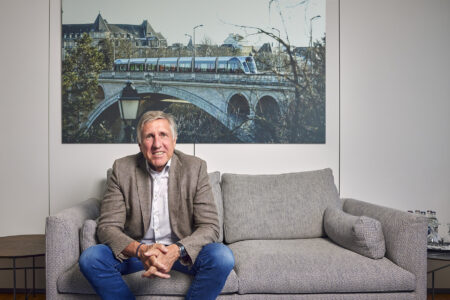Minister Bausch, what are the main mobility challenges that Luxembourg is facing today, and the most efficient and sustainable means for overcoming them?
 François Bausch: Developing efficient and sustainable mobility solutions is one of the most important challenges in the 21st century, not only in Luxembourg but generally for humanity. In addition to the pressing need to react to climate change and achieve better sustainability, the United Nations expects 85% of the world’s population to live in large urban areas by 2050. This means that urban areas must be organised in a completely different way, otherwise they will not function. It is striking that cities such as Copenhagen, Vienna and Montreal, which are frontrunners in mobility systems innovation, are almost always ranked at the top in terms of investment attractiveness, productivity and quality of life, for example.
François Bausch: Developing efficient and sustainable mobility solutions is one of the most important challenges in the 21st century, not only in Luxembourg but generally for humanity. In addition to the pressing need to react to climate change and achieve better sustainability, the United Nations expects 85% of the world’s population to live in large urban areas by 2050. This means that urban areas must be organised in a completely different way, otherwise they will not function. It is striking that cities such as Copenhagen, Vienna and Montreal, which are frontrunners in mobility systems innovation, are almost always ranked at the top in terms of investment attractiveness, productivity and quality of life, for example.
The challenge is to create an innovative multimodal system where everyone can have access to all means of transports and combine them in an intelligent and efficient way.
I consider the whole of Luxembourg, with its 645,000 inhabitants and additional 230,000 cross-border commuters from neighbouring countries, as a large urban area. Our current mobility system is mainly based on individual motorised transport, or, in other words, cars that are not used in a very efficient manner. The challenge is to create an innovative multimodal system where everyone can have access to all means of transports – cars, trains, buses, bikes, and so on – and combine them in an intelligent and efficient way.
This is already well underway in Luxembourg. The new tramline in the city will, once it has been finished in 2024, include nine multimodal platforms that interconnect various transport modes. Digitalisation is a great tool to help solve the problems.
You recently presented the government’s new mobility plan for 2035. What are the key milestones that you want to achieve by then?
The need and demand for mobility have constantly increased in the past decades, and this trend will only continue. Our aim must be to move people – not vehicles.
Our aim must be to move people – not vehicles.
Our main target is therefore to use existing mobility infrastructure efficiently. Today, we tend to look at roads as infrastructure for cars. Instead, we need to consider them as multimodal corridors for mobility with space for cars, pedestrians, cyclists, trams and buses. There are also new tools on the way that will offer us new possibilities to have more efficient mobility. The autonomous cars that will come on the market in the next 10-15 years will be a real game changer.
What role can innovative companies play in implementing your vision?
I see Luxembourg as a laboratory for innovative and sustainable mobility, so I welcome all start-ups and companies to come here and test and experiment with their new, sustainable mobility solutions! Luxembourg is interesting for many reasons: it is a small country with an economic basis that is within a perimeter of 50 km, which offers a lot of flexibility for implementing new mobility solutions. It is also a very international place with numerous representatives from German, French and English-speaking cultures, which makes it possible to test the uptake of new innovations by people from different backgrounds in one single location.
I welcome all start-ups and companies to come here and test and experiment with their new, sustainable mobility solutions.
In what areas linked to smart mobility does Luxembourg stand out internationally?
It was amazing to see the huge international attention attracted when we, as the first country in the world, made all public transport free of charge in 2020. However, this is just a small part of our strategy, and it is increasingly recognised that we are also champions in investing in mobility infrastructure. Luxembourg has become what I always wanted, namely a laboratory where we can show that innovation in the mobility sector is a key asset to make economies more competitive and productive.
And the final question: what means of transport do you use yourself?
I’m multimodal. As long as I’m moving around in Luxembourg City I use my bike, walk or take the bus. I also frequently use the new tram. I take my car too, mainly when I need to go outside the city. I would say that 80-85% of my moving around is done by soft mobility, and the remaining 15-20% by car.
Photo: © Luxinnovation/Eric Devillet

